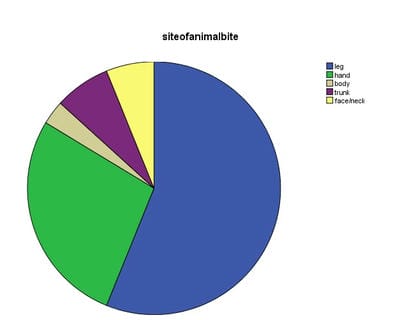An epidemiological study of dog bite cases in a rural area of Salem, Tamil Nadu
Sangeetha S.1*, Shakthi Shri Hari M.V.2, Devi M.3, Kumar R.4, Sathana R.5, Renasre M.6, Shanadhani K.7
DOI: https://doi.org/10.17511/ijphr.2018.i2.08
1* Sangeetha S., Professor and HOD, Department of Community Medicine, Vinayaka Mission’s Kirupananda Variyar Medical College Hospital, Salem, Tamil Nadu, India.
2 Shakthi Shri Hari M.V., Interns, Vinayaka Mission’s Kirupananda Variyar Medical College Hospital, Salem, Tamil Nadu, India.
3 M. Sarala Devi, Interns, Vinayaka Mission’s Kirupananda Variyar Medical College Hospital, Salem, Tamil Nadu, India.
4 R. Saravana Kumar, Interns, Vinayaka Mission’s Kirupananda Variyar Medical College Hospital, Salem, Tamil Nadu, India.
5 Sathana R., Interns, Vinayaka Mission’s Kirupananda Variyar Medical College Hospital, Salem, Tamil Nadu, India.
6 Renasre M., Interns, Vinayaka Mission’s Kirupananda Variyar Medical College Hospital, Salem, Tamil Nadu, India.
7 Shanadhani K., Interns, Vinayaka Mission’s Kirupananda Variyar Medical College Hospital, Salem, Tamil Nadu, India.
Introduction: Rabies is a viral zoonosis. In up to 99% of cases, domestic dogs are responsible for rabies virus transmission to humans. About 30% of the victims of dog bites are children under the age of 15. Objective: To assess the epidemiological pattern of dog bite cases, which formed the majority of cases attending anti-rabies clinic. Materials and Methods: This study was conducted at the Primary Health Centre,Poolavari, Salem, Tamil Nadu, India between Feb 1st- May 1st 2018. It is a cross sectional study, where all dog bite cases attending injection OPD were studied. Results: Highest percentage of dog bite victims belonged to the age group of 5-25Years (33.7%). The bites were mostly by pet dogs (75.5%). 91.8% of the dogs were not vaccinated. Running, patting were the most common factors leading to dog bites (50.0%). 52% of the study population had awareness of first aid for dog bite. 88.8% population had awareness about Anti rabies vaccines for dog bites. Conclusion: The study concludes that awareness of first aid for dog bites ,pet dog vaccination, awareness about Anti rabies vaccine for dog bites and completion of the treatment should be increased in the rural population.
Keywords: Dog bite, Rural Area, Vaccination, Epidemiology
| Corresponding Author | How to Cite this Article | To Browse |
|---|---|---|
| , Professor and HOD, Department of Community Medicine, Vinayaka Mission’s Kirupananda Variyar Medical College Hospital, Salem, Tamil Nadu, India. Email: |
Sangeetha S, Shakthi SHMV, Sarala MD, Kumar RS, Sathana R, Renasre M, Shanadhani K. An epidemiological study of dog bite cases in a rural area of Salem, Tamil Nadu. Public Health Rev Int J Public Health Res. 2018;5(2):99-104. Available From https://publichealth.medresearch.in/index.php/ijphr/article/view/89 |


 ©
© 